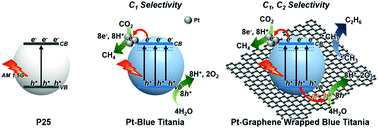当前位置:
X-MOL 学术
›
Energy Environ. Sci.
›
论文详情
Our official English website, www.x-mol.net, welcomes your
feedback! (Note: you will need to create a separate account there.)
High-rate solar-light photoconversion of CO2 to fuel: controllable transformation from C1 to C2 products†
Energy & Environmental Science ( IF 32.4 ) Pub Date : 2018-07-09 00:00:00 , DOI: 10.1039/c8ee00983j Saurav Sorcar 1, 2, 3, 4 , Jamie Thompson 5, 6, 7, 8 , Yunju Hwang 1, 2, 3, 4 , Young Ho Park 1, 2, 3, 4 , Tetsuro Majima 9, 10, 11, 12 , Craig A. Grimes 13, 14, 15 , James R. Durrant 5, 6, 7, 8 , Su-Il In 1, 2, 3, 4
Energy & Environmental Science ( IF 32.4 ) Pub Date : 2018-07-09 00:00:00 , DOI: 10.1039/c8ee00983j Saurav Sorcar 1, 2, 3, 4 , Jamie Thompson 5, 6, 7, 8 , Yunju Hwang 1, 2, 3, 4 , Young Ho Park 1, 2, 3, 4 , Tetsuro Majima 9, 10, 11, 12 , Craig A. Grimes 13, 14, 15 , James R. Durrant 5, 6, 7, 8 , Su-Il In 1, 2, 3, 4
Affiliation

|
The production of solar fuels offers a viable pathway for reducing atmospheric CO2 concentrations and the storage and transport of solar energy. While photoconversion of CO2 into C1 hydrocarbon products, notably methane (CH4), is known, the ability to directly achieve significant quantities of higher-order hydrocarbons represents an important step towards practical implementation of solar fuel technologies. We describe an efficient, stable, and readily synthesized CO2-reduction photocatalyst, Pt-sensitized graphene-wrapped defect-induced blue-coloured titania, that produces a record high combined photocatalytic yield of ethane (C2H6) and methane. For the first time, a systematic ultraviolet photoelectron spectroscopy study on the mechanism underlying ethane formation indicates that the process is dependent upon upward band bending at the reduced blue-titania/graphene interface. Furthermore, transient absorption spectroscopy indicates photogenerated holes move into the graphene while electrons accumulate on the Ti3+ sites, a phenomenon contradicting prior assumptions that graphene acts as an electron extractor. We find that both mechanisms serve to enhance multielectron transfer processes that generate ˙CH3. Utilizing a continuous flow-through (CO2, H2O) photoreactor, over the course of multiple 7 h runs approximate totals of 77 μmol g−1 C2H6 and 259 μmol g−1 CH4 are obtained under one sun AM 1.5G illumination. The photocatalyst exhibits an apparent quantum yield of 7.9%, 5.2% CH4 and 2.7% C2H6, and stable photocatalytic performance over the test duration of 42 h. The carbon source for both products is verified using 13CO2 isotopic experiments.
中文翻译:

CO 2的高速率太阳光光转化为燃料:从C 1到C 2产物的可控转化†
太阳能燃料的生产为降低大气中的CO 2浓度以及太阳能的存储和运输提供了一条可行的途径。尽管已知将CO 2光转化为C 1烃类产品,尤其是甲烷(CH 4),但是直接获得大量高级碳氢化合物的能力代表了朝着太阳能技术实际应用迈出的重要一步。我们描述了一种高效,稳定且易于合成的CO 2还原光催化剂,Pt敏化的石墨烯包裹的缺陷诱导的蓝色二氧化钛,可产生创纪录的乙烷(C 2 H 6)和甲烷。关于乙烷形成机理的系统紫外光电子光谱学研究首次表明,该过程取决于还原的蓝-二氧化钛/石墨烯界面上的向上带弯曲。此外,瞬态吸收光谱法表明,当电子累积在Ti 3+位上时,光生空穴向石墨烯移动,这种现象与石墨烯充当电子提取器的先前假设相矛盾。我们发现,这两种机制起到提升产生CH多电子转移过程3。利用连续的流通式(CO 2,H 2 O)光反应器,在多个7小时的运行过程中,总计约77μmolg -1在一个太阳AM 1.5G照射下获得C 2 H 6和259μmolg -1 CH 4。在42小时的测试时间内,该光催化剂的表观量子产率为7.9%,5.2%CH 4和2.7%C 2 H 6,并且具有稳定的光催化性能。使用13个CO 2同位素实验验证了这两种产品的碳源。
更新日期:2018-07-09
中文翻译:

CO 2的高速率太阳光光转化为燃料:从C 1到C 2产物的可控转化†
太阳能燃料的生产为降低大气中的CO 2浓度以及太阳能的存储和运输提供了一条可行的途径。尽管已知将CO 2光转化为C 1烃类产品,尤其是甲烷(CH 4),但是直接获得大量高级碳氢化合物的能力代表了朝着太阳能技术实际应用迈出的重要一步。我们描述了一种高效,稳定且易于合成的CO 2还原光催化剂,Pt敏化的石墨烯包裹的缺陷诱导的蓝色二氧化钛,可产生创纪录的乙烷(C 2 H 6)和甲烷。关于乙烷形成机理的系统紫外光电子光谱学研究首次表明,该过程取决于还原的蓝-二氧化钛/石墨烯界面上的向上带弯曲。此外,瞬态吸收光谱法表明,当电子累积在Ti 3+位上时,光生空穴向石墨烯移动,这种现象与石墨烯充当电子提取器的先前假设相矛盾。我们发现,这两种机制起到提升产生CH多电子转移过程3。利用连续的流通式(CO 2,H 2 O)光反应器,在多个7小时的运行过程中,总计约77μmolg -1在一个太阳AM 1.5G照射下获得C 2 H 6和259μmolg -1 CH 4。在42小时的测试时间内,该光催化剂的表观量子产率为7.9%,5.2%CH 4和2.7%C 2 H 6,并且具有稳定的光催化性能。使用13个CO 2同位素实验验证了这两种产品的碳源。











































 京公网安备 11010802027423号
京公网安备 11010802027423号